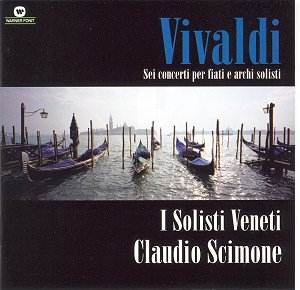It is good to report
that these days one can listen to Baroque
music played on modern instruments without
feeling a nagging sense of guilt. Of
course, I Solisti Veneti have been doing
this for years, but have now lost some
of that somewhat recherché
quality.
In any case, Vivaldi
has always arguably been the 18th
century composer who works best on modern
instruments. His music has such a brilliant
surface, and sometimes flirts so dangerously
with vacuity, that the projection and
dynamic range of modern instruments
suits it down to the ground.
This recording is very
easy on the ear; the balance is good,
so that one can hear the details most
of the time. Most of the performers,
particularly those on wind instruments,
play with style and flair. The music
is delightful, and will make an ideal
‘follow-up’ for someone who likes the
Four Seasons and wishes to explore
more Vivaldi. Indeed, the C major concerto
for the unusual combination of violin
and two cellos is like a re-hash of
the Seasons. The opening theme
features a rhythm identical to the first
movement of Spring, while the
Largo has an expressive violin
solo over pizzicato strings, much as
in the middle movement of Winter.
The first three tracks
are taken up with the delightful Concerto
in D for violin, two oboes, two horns,
strings and timpani. Very odd (to the
point of downright suspicious!) to find
a piece from this period in D with timps
and no trumpets, but there we are. But
here a major problem began to emerge.
The violin playing of the principal
soloist, Lucio Degani, is cloyingly
romantic and lacks rhythmic poise. Linked
with this, he displays a desire to hold
the music up, to distort the underlying
pulse to the considerable detriment
of the music. This difficulty emerges
elsewhere, and seems to have infected
his colleagues. Chiara Parrini, for
example, who takes the violin solo in
the C major concerto mentioned above,
plays the charming slow movement with
a sweetness that spills over into camp
– not nice.
On the plus side, the
playing of Roberto Giaccaglia, bassoon
soloist in the fine D minor solo concerto
for that instrument (one of thirty-nine,
no less) is very beautiful – expressive
and clearly articulated at all times.
Nice to hear a bassoon used for basso
continuo here too. The oboists Gianni
Viero and Silvano Scanziani deal splendidly
with the often very florid writing in
RV 534 and RV 535. A pity, then, that
the beautiful slow movement of the latter
is all but ruined by an entirely unnecessary
meandering right-hand part that has
been added by the organ continuo player.
The fact that it is almost inaudible
makes it, oddly, even worse; you find
yourself thinking "could you pack
it in please?". On the other hand,
the slow movement of RV 534 is spoiled
by dodgy intonation between oboes and
bassoon (guilty fagottist I fear) –
possibly an inadvisable early morning
take with cold instruments.
The best is left to
last. RV 566, with its solo line-up
of two violins, two flutes, two oboes
and bassoon, is utterly delightful,
and characteristic of the composer at
his most inventive. The finale is huge
fun, with odd phrase lengths and sliding
chromatic lines. I very much enjoyed
the way the harpsichord continuo wittily
filled in the off-beat ‘gaps’ in the
tune.
An entertaining disc,
then, though not one that can be recommended
in an unqualified way. There are definite
rough edges, yet the playing has a relaxed
quality which arises from the players’
affectionate familiarity with this music
and its world.
Gwyn Parry-Jones


